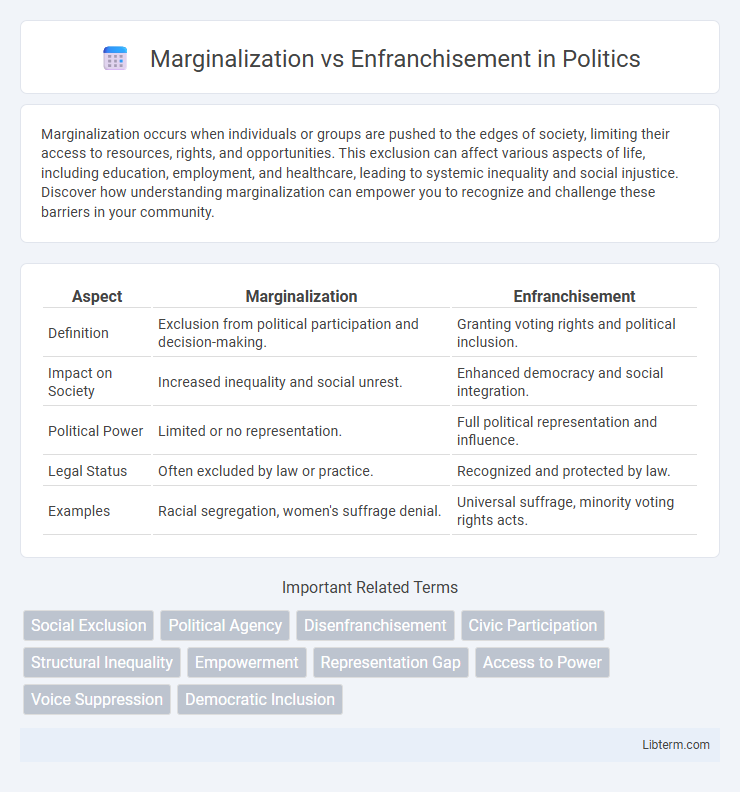Marginalization occurs when individuals or groups are pushed to the edges of society, limiting their access to resources, rights, and opportunities. This exclusion can affect various aspects of life, including education, employment, and healthcare, leading to systemic inequality and social injustice. Discover how understanding marginalization can empower you to recognize and challenge these barriers in your community.
Table of Comparison
| Aspect | Marginalization | Enfranchisement |
|---|---|---|
| Definition | Exclusion from political participation and decision-making. | Granting voting rights and political inclusion. |
| Impact on Society | Increased inequality and social unrest. | Enhanced democracy and social integration. |
| Political Power | Limited or no representation. | Full political representation and influence. |
| Legal Status | Often excluded by law or practice. | Recognized and protected by law. |
| Examples | Racial segregation, women's suffrage denial. | Universal suffrage, minority voting rights acts. |
Understanding Marginalization: Definition and Impacts
Marginalization refers to the social process by which certain groups or individuals are pushed to the edges of society, limiting their access to resources, rights, and opportunities. This exclusion results in diminished political, economic, and social participation, often leading to poverty, discrimination, and reduced self-worth. Understanding marginalization is crucial for addressing systemic inequalities and fostering inclusive policies that promote enfranchisement and equal rights for marginalized communities.
Enfranchisement Explained: An Overview
Enfranchisement refers to the granting of rights, particularly voting rights, to individuals or groups previously excluded from political participation, enabling active engagement in democratic processes. This expansion of rights fosters inclusivity, empowerment, and equality within societies by recognizing marginalized populations as legitimate stakeholders. Key examples include historical movements such as the extension of suffrage to women and minority groups, which transformed political landscapes and promoted social justice.
Historical Contexts: From Marginalization to Enfranchisement
Historical contexts reveal a profound shift from marginalization to enfranchisement, with marginalized groups often denied political, social, and economic rights throughout history. Movements such as the civil rights struggle in the United States and the anti-apartheid campaign in South Africa demonstrate how enfranchisement emerged through sustained activism and legal reforms. This evolution underscores the critical role of historical power dynamics and resistance in expanding democratic participation and social inclusion.
Key Factors Driving Marginalization
Key factors driving marginalization include systemic discrimination, economic inequality, and limited access to education and healthcare, which collectively restrict opportunities for disadvantaged groups. Social exclusion and political disenfranchisement perpetuate cycles of poverty and powerlessness, hindering active participation in societal decision-making. Understanding these drivers is crucial for developing policies that promote enfranchisement and equitable inclusion.
Mechanisms of Enfranchisement in Society
Mechanisms of enfranchisement in society include legal reforms such as the extension of voting rights, anti-discrimination laws, and policies promoting equal access to education and employment. Institutional measures like voter registration drives, civic education programs, and community engagement initiatives empower marginalized groups by enhancing political participation and social inclusion. These mechanisms collectively work to reduce systemic barriers, fostering a more equitable distribution of power and resources.
Economic Consequences: Marginalized vs. Empowered Groups
Marginalization often results in limited access to economic resources, job opportunities, and financial capital, perpetuating cycles of poverty and economic instability for affected groups. In contrast, enfranchised and empowered groups benefit from increased economic participation, higher income levels, and greater influence over economic policies, driving community development and wealth accumulation. Economic disparities between marginalized and empowered groups highlight the critical need for inclusive policies that promote equitable access to education, credit, and employment.
Social and Political Representation: Bridging the Gap
Marginalization limits access to political power and social resources, resulting in underrepresentation of minority groups in decision-making processes. Enfranchisement expands voting rights and promotes inclusive policies, fostering equitable social and political representation. Bridging the gap requires targeted reforms, community empowerment, and legal protections to ensure all voices contribute to governance and societal development.
Case Studies: Successes in Overcoming Marginalization
Case studies such as the civil rights movement in the United States demonstrate how enfranchisement initiatives, including the Voting Rights Act of 1965, effectively dismantled systemic barriers to voting for African Americans, leading to increased political representation and social equity. In India, the reservation system for Scheduled Castes and Tribes has significantly improved access to education and employment, showcasing policies that transform marginalized groups into empowered citizens. Similarly, South Africa's post-apartheid reforms, like the establishment of inclusive electoral processes, highlight successful enfranchisement strategies that foster social cohesion and rectify historical injustices.
Challenges and Barriers to Enfranchisement
Marginalization impedes enfranchisement by embedding systemic barriers such as discriminatory laws, socioeconomic disparities, and limited access to education, which restrict marginalized groups from exercising their voting rights. Challenges to enfranchisement include voter ID laws, gerrymandering, and inadequate voter registration processes, disproportionately affecting minority communities. Overcoming these obstacles requires targeted policy reforms, increased civic education, and the enforcement of equal voting rights to ensure inclusive political participation.
Future Directions: Creating Inclusive Societies
Future directions for creating inclusive societies prioritize dismantling systemic barriers that cause marginalization through policies ensuring equal access to education, healthcare, and employment. Empowering marginalized groups with political enfranchisement fosters social cohesion and equitable representation in decision-making processes. Technological innovation combined with community engagement offers scalable solutions for amplifying diverse voices and reducing inequalities globally.
Marginalization Infographic

 libterm.com
libterm.com